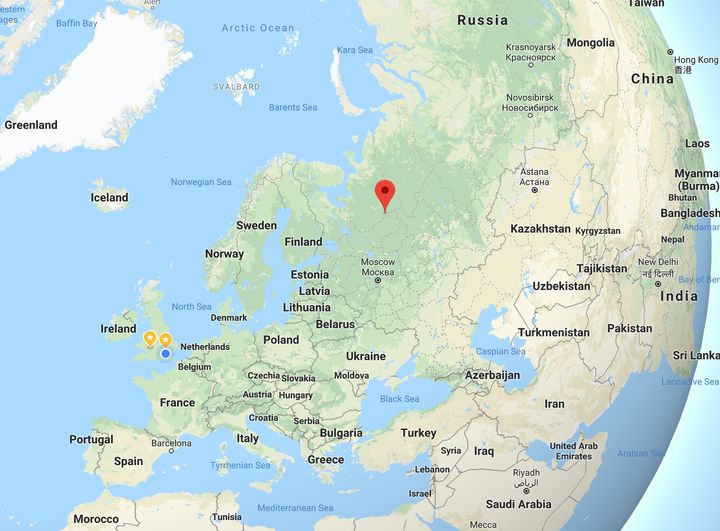The second Russian man suspected of poisoning Sergei Skripal in March has been unmasked by the Bellingcat website as a doctor employed by Russia’s GRU intelligence agency.
The revelation blows yet another hole in the official narrative put forward by the Kremlin which, using a interview on Russian state media, tried to pass the two men off as tourists on a two-day international jaunt to visit Salisbury Cathedral.
Russia continues to deny the allegations, with President Vladimir Putin saying last month there was “nothing criminal” about the two men.
Here’s everything we know about the suspects so far:
‘Alexander Petrov’

Real Name: Dr Alexander Yevgenyevich Mishkin, according to the investigative website, Bellingcat.
Occupation: Military doctor employed by GRU, the Russian military intelligence agency.
Born: 13 July 1979 in the village of Loyga, northern Russia.

Career: Not known for certain before 2001, but according to Bellingcat, Mishkin enrolled at the S. Kirov Military Medical Academy (VMEDA) and graduated in 2003/04 with a medical degree and given rank of Senior Lieutenant.
He is then alleged to have moved to Moscow no later than 2010, where he received the undercover identity of Alexander Petrov.
He was later awarded Russia’s highest accolade, the Hero of the Russian Federation by President Vladimir Putin in 2014, possibly for activities in Crimea.
Between 2011 and 2018 he travelled extensively under his new identity, Bellingcat said, including making frequent trips to Ukraine.
The last of these was reportedly in December 2013, just ahead of the 2014 Ukrainian revolution which led to Russia’s annexation of Crimea.
How Was He Identified?
Bellingcat only had the CCTV photos released by the UK Government and the passport of Mishkin’s undercover alias to work with and quickly ruled out the possibility of him having any social media presence.
An extensive search of both public and leaked Russian databases established the first name and birth date used on his alias were in fact true, and only his last name had been changed when he went undercover.
Until September 2014, his home address was registered as the Moscow headquarters of the GRU.
Bellingcat investigator Cristo Grozev said: “They confirmed that their homeboy Alexander Mishkin was the person who moved on to military school and then became a famous military doctor, and who received the award of Hero of the Russian Federation personally from President Putin.
He told a news conference in the Houses of Parliament on Tuesday: “His grandmother with whom he grew up, who happens to be medical professional, has a photograph, in her own words, that has been seen by everybody in the village, of President Putin shaking Mishkin’s hand and giving him the award.”
‘Ruslan Boshirov’

Real Name: Colonel Anatoliy Chepiga
Occupation: Clandestine GRU Officer
Born: 5 April 1979 in Nikolaevka, near the Russia-Ukraine border

Career: Enrolled in Far Eastern Military Command School at the age of 18, where his name appears on an honours wall, according to Bellingcat.
Served in the elite 14th Spetsnaz Brigade upon graduation. Details of the operations he took part in are not known, but he was allegedly deployed to Chechnya three times.
He received his undercover alias sometime between 2003 and 2010.
Chepiga was also awarded the Hero of the Russian Federation award by President Vladimir Putin in 2014, receiving a luxury Moscow flat at the same time.
How Was He Identified?
Bellingcat asked former Russian military officers which military schools would provide the kind of training Chepiga would need for his undercover role, which gave them the name of the Far Eastern Military Command School.
After browsing through yearbooks, one person was found who resembled a young Boshirov. This person had been awarded the Hero of the Russian Federation award and was named Anatoliy Chepiga.
This name was then cross-referenced with both public and leaked Russian databases, which provided further evidence they are in fact the same person – including residential phone numbers and another passport.
The Third Suspect
The latest revelation comes after UK police identified a third Russian accomplice alleged to have helped plan the Salisbury nerve agent attack.
The man, from Russia’s military intelligence service the GRU, was reported to have visited Salisbury ahead of the poisoning of Sergei Skripal and his daughter Yulia, according to The Daily Telegraph.
The suspect is thought to have fed back details such as the layout of the cul-de-sac where Skripal lived and which door he used to enter and leave.
The Press Association has confirmed the investigation is looking at several suspects, with a senior government source stating that there are “at least two”. An exact number has not been confirmed, but the source said there were “multiple suspects” being investigated.
The Other GRU Plots
Last week it was revealed the GRU was also behind a string of computer hacking programmes to undermine democracies, targeting institutions from sports anti-doping bodies to the chemical weapons watchdog.
A four-strong team were caught “in flagrante”, according to officials, as they attempted to hack into the computer system of the Organisation for the Prohibition of Chemical Weapons (OPCW) in The Hague.
They were then sent packing to Moscow by Dutch security services, leaving behind them a treasure trove of intelligence about the GRU’s covert activities around the world.
Russia denied what its Foreign Ministry spokeswoman called a “diabolical perfume cocktail” of allegations dreamt up by someone with a “rich imagination”.
